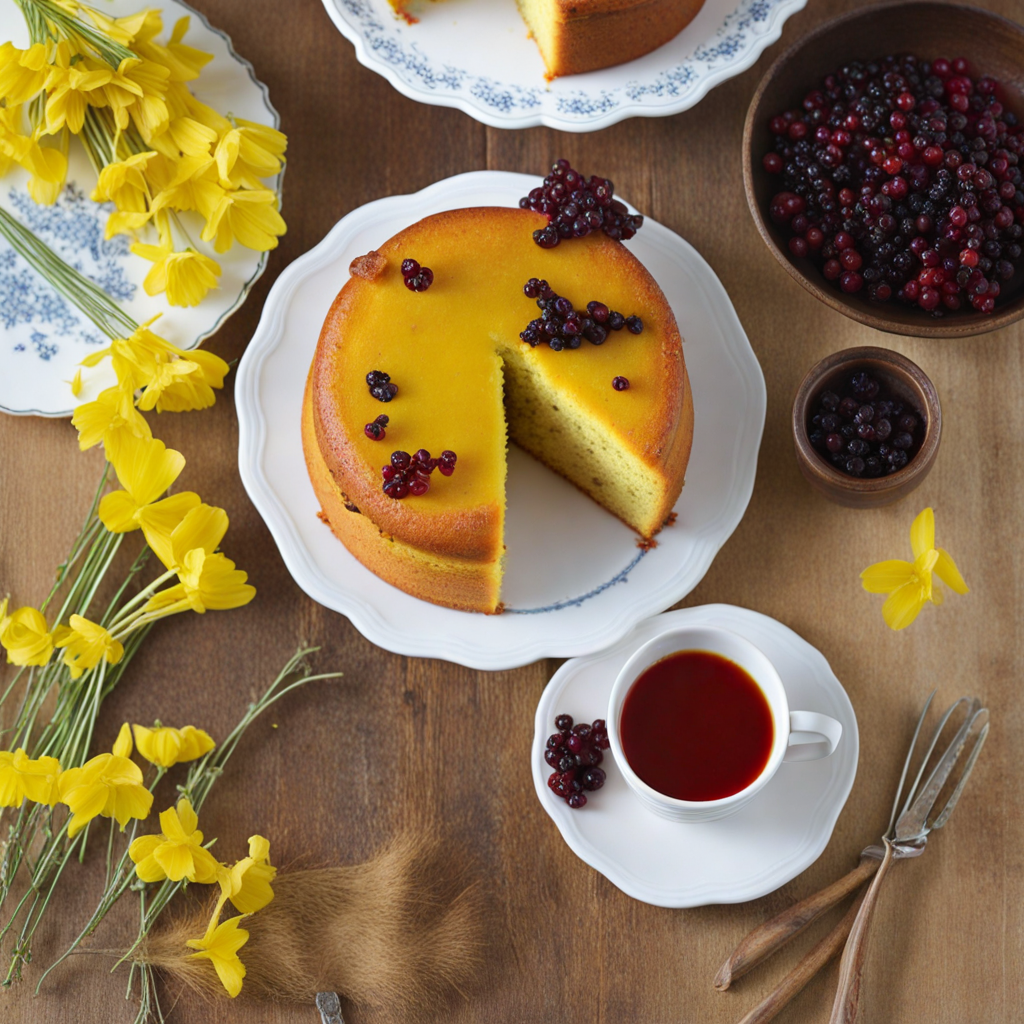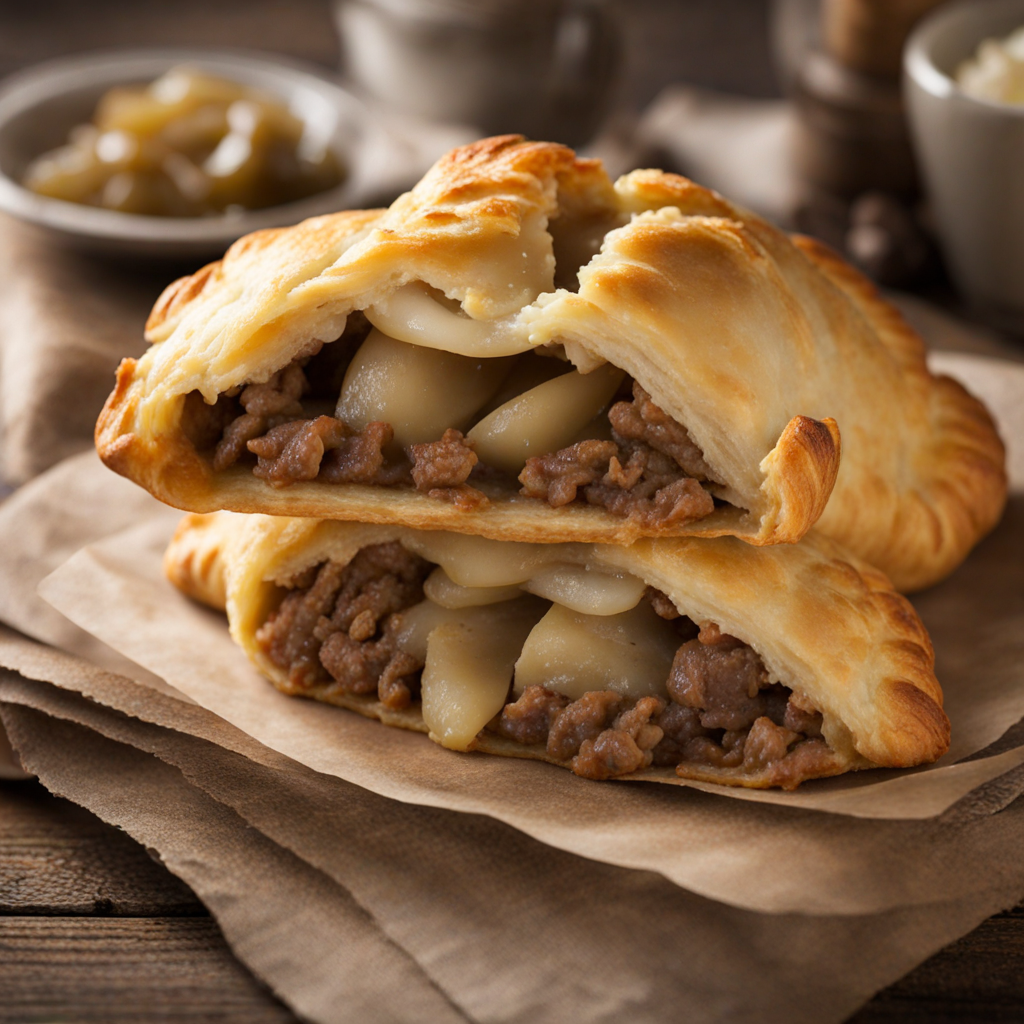Cornish Saffron Cake
Cornish Saffron Cake is a delightful and aromatic treat that hails from the picturesque region of Cornwall in the United Kingdom. This unique cake is characterized by its rich golden hue, which comes from the infusion of saffron—a luxurious spice derived from the flower of Crocus sativus. The cake is traditionally made using a combination of flour, butter, sugar, and eggs, with the saffron threads steeped in warm milk to release their vibrant color and distinctive flavor. The result is a moist, crumbly texture that melts in your mouth, making each bite a heavenly experience. The flavor profile of Cornish Saffron Cake is both subtle and complex. The warmth of the saffron is complemented by hints of spices such as nutmeg and cinnamon, which add depth and warmth to the cake. Often, dried fruits like currants or raisins are folded into the batter, providing bursts of sweetness that balance the earthiness of the saffron. This cake is not overly sweet, allowing the natural flavors to shine through, making it an excellent accompaniment to a cup of tea or coffee. Traditionally served during festive occasions and gatherings, Cornish Saffron Cake carries a sense of history and heritage. Its roots can be traced back to the 19th century, and it continues to be a beloved staple in Cornish cuisine. Whether enjoyed as a dessert or a snack, this cake embodies the essence of Cornwall’s culinary traditions, inviting those who taste it to savor a slice of history and culture. Each bite tells a story of the land, the people, and the cherished recipes passed down through generations.
How It Became This Dish
The History of Cornish Saffron Cake Cornish Saffron Cake, a delightful and aromatic treat, is a celebrated delicacy that hails from the picturesque region of Cornwall in the United Kingdom. This cake, rich in history and cultural significance, encapsulates the essence of Cornish culinary traditions while offering a glimpse into the agricultural practices and social customs of the area. Its story intertwines with the history of saffron cultivation, the evolution of baking traditions, and the unique identity of Cornwall itself. #### Origins of Cornish Saffron Cake The origins of Cornish Saffron Cake can be traced back to the 16th century, during a time when the cultivation of saffron flourished in the region. Saffron, derived from the flower of Crocus sativus, was introduced to England from the Middle East and became highly prized for its vibrant color and distinctive flavor. Cornwall, with its temperate climate and fertile soil, proved to be an ideal location for saffron cultivation, and by the 16th century, it became one of the primary saffron-producing regions in England. The use of saffron in baking, particularly in cakes, became popular among the Cornish as it was believed to symbolize wealth and prosperity. The cake itself likely evolved from earlier bread-making traditions where saffron was mixed with simple ingredients such as flour, sugar, and butter. The addition of dried fruits such as currants, sultanas, and sometimes almonds lent the cake further richness and texture. #### Cultural Significance Cornish Saffron Cake is more than just a culinary treat; it embodies the spirit and heritage of Cornwall. Traditionally, it was baked for special occasions, including weddings, harvest festivals, and religious celebrations. The cake's bright yellow hue, courtesy of saffron, was seen as a symbol of joy and festivity. It was often served alongside other traditional Cornish foods, such as the famous Cornish pasties, during gatherings and community events. The cake also holds a place in Cornish folklore and history. Its prominence in local celebrations and rituals highlights the importance of agriculture and seasonal cycles in Cornish culture. The act of baking and sharing the saffron cake with family and friends reinforced social bonds and community spirit, showcasing how food acts as a medium for connection and cultural expression. #### Development Over Time As time progressed, the recipe for Cornish Saffron Cake underwent various adaptations while retaining its core identity. In the 19th century, with the advent of the Industrial Revolution, the availability of ingredients and baking techniques expanded. This led to an influx of variations in the cake's preparation, with some bakers opting to use more refined sugars and modern baking methods. Nevertheless, the traditional recipe remained popular, especially among families who passed it down through generations. During this period, the cake's popularity spread beyond Cornwall, becoming a beloved item in bakeries and tea shops across the United Kingdom. The Victorian era, known for its lavish tea parties and social gatherings, saw the Cornish Saffron Cake being served as an elegant addition to afternoon tea. Its unique flavor profile and beautiful appearance made it a desirable choice among the upper classes, further elevating its status. However, the 20th century brought challenges to traditional culinary practices, as industrialization and globalization influenced food production and consumption. Local saffron production dwindled, and many bakers began to use artificial flavorings and colorings to replicate the saffron effect. This shift sparked a movement among food historians and culinary enthusiasts to revive authentic recipes and traditional methods. In recent decades, there has been a resurgence of interest in regional foods and traditional baking practices, leading to a revival of the Cornish Saffron Cake. Local bakeries and home bakers have embraced the original recipe, emphasizing the use of quality saffron and local ingredients. This revival aligns with a broader trend of appreciating artisanal and locally-sourced foods, as consumers increasingly seek authenticity and connection to their culinary heritage. #### Saffron Cultivation and Modern Adaptations Today, the cultivation of saffron in Cornwall is experiencing a renaissance, with a number of small-scale farmers reintroducing saffron farming to the region. These farmers are committed to sustainable practices and preserving the unique agricultural heritage of Cornwall. The renewed interest in saffron has also spurred local culinary events and festivals, celebrating the history and significance of Cornish Saffron Cake. Modern adaptations of the cake have emerged as well, reflecting contemporary tastes and dietary considerations. While traditional recipes remain cherished, some bakers experiment with gluten-free options, alternative sweeteners, and even vegan versions of the cake. These innovations allow the Cornish Saffron Cake to be enjoyed by a wider audience while still honoring its historical roots. #### Conclusion The story of Cornish Saffron Cake is a rich tapestry woven with threads of history, culture, and culinary tradition. From its origins in 16th-century Cornwall, where saffron cultivation thrived, to its role in community celebrations and its evolution through the ages, the cake remains a symbol of Cornish identity. As local farmers revive saffron production and bakers honor traditional recipes, the Cornish Saffron Cake continues to be a beloved treat that unites generations and reflects the enduring legacy of Cornwall’s culinary heritage. In embracing both its historical significance and modern interpretations, the Cornish Saffron Cake stands as a testament to the power of food to connect us to our roots, celebrate our communities, and nourish our souls. Whether enjoyed during a festive occasion or as a comforting homemade treat, this cake encapsulates the spirit of Cornwall, inviting all who taste it to partake in its storied history.
You may like
Discover local flavors from United Kingdom







